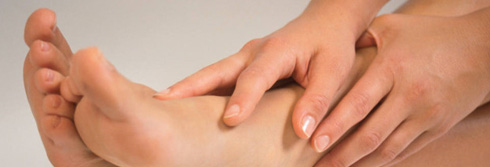
Foot Pain
The most common cause of foot pain are:
- Navicular Stress Fractures
- Midtarsal Joint Sprains
- Extensor Tendinopathy
- Stress Fractures of the Metatarsals
- Turf Toe
- Inflammation of the Sesamoid Bones
- Morton's Neuroma
- Other Foot Problems
Navicular Stress Fractures
The history of navicular stress fractures is one of a poorly localised midfoot ache associated with activity. Suspicion of a navicular stress fracture requires further investigations and careful management over a six week period of immobilisation. Following immobilisation the patient will require intensive physiotherapy to mobilse stiff joints in the ankle and foot as well as strengthening and stretching muscles.
Midtarsal Joint Sprains
Gymnasts, jumpers and footballers commonly present with midtarsal joint sprains. Most commonly this injury affects the calcaneonavicular ligament. Treatment involves reducing inflammation, taping and the possible prescription of orthoses.
Extensor Tendinopathy
Extensor tendinopathy is a result of overuse and presents as an ache across the top of the foot. Treatment involves strengthening the extensor muscles and altering the training load. Another cause of this condition is compression by excessively tight shoelaces. This is simply corrected by a change of lacing pattern or by placing adhesive foam under the tongue of the shoe.
Stress Fractures of the Metatarsals
Stress fractures of the metatarsals are a result of overuse with the patient complaining of forefoot pain aggravated by running or dancing. The pain is not severe initially but gradually worsens with activity. These injuries require X-ray, four to eight weeks weight bearing rest and possibly orthoses.
Turf Toe
Turf toe is the common name for a sprain of the joint at the big toe. It results from vigorous bending at the joint with pain on movement. The result is a sprain of the joint capsule and the ligament on the under surface of the big toe. Treatment involves ice, decreased weight bearing for at least 72 hours and taping.
Inflammation of the Sesamoid Bones
The sesamoid bones under the ball of the foot may become inflamed as a result of landing from a jump or increased forefoot weight bearing activities (sprinting and dancing). Treatment involves ice, padding and technique correction in the aggravating activity.
Morton's Neuroma
Morton's neuroma is a swelling of nerve and scar tissue arising from compression of a nerve between the third and forth metatarsals. The patient complains of pain radiating into the toes, often associated with pins and needles and numbness. Pain is increased by forefoot weight bearing activities and with narrow fitting footwear. Treatment includes ice, padding, intrinsic foot muscle strengthening and in some cases orthoses.
Other Foot Problems
Other foot problems range from corns calluses and nail problems to bone and joint abnormalities. Forefoot pain is especially common in athletes participating in kicking sports and among ballet dancers.
Book now to arrange an immediate appointment
To arrange an appointment or to speak to a physiotherapist, please call our friendly reception staff on 0161 883 0640 or email office@stockportphysio.co.uk

